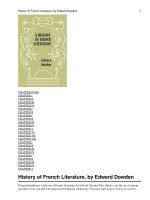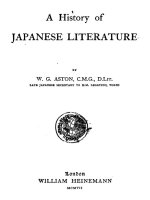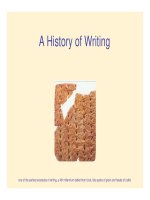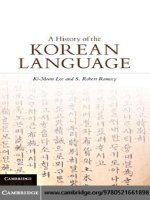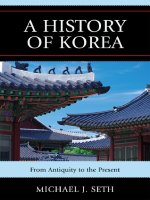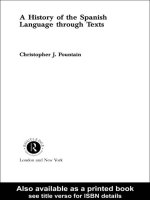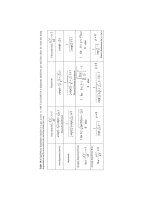a history of icelandic literature
Bạn đang xem bản rút gọn của tài liệu. Xem và tải ngay bản đầy đủ của tài liệu tại đây (3.51 MB, 749 trang )
A History of Icelandic Literature
Histories of Scandinavian Literature
Sven H. Rossel, General Editor
volume 5
A History of
Icelandic Literature
Edited by Daisy Neijmann
Published by
the University of
Nebraska Press,
Lincoln & London,
in cooperation
with The American-
Scandinavian Foundation
Publication of this book was
assisted by grants from the
National Endowment for
the Humanities, the
National Endowment for
the Arts, and from the Fund
for the Promotion of
Icelandic Literature.
∫ 2006 by the Board of
Regents of the University
of Nebraska
All rights reserved
Manufactured in the United
States of America
!
Library of Congress
Cataloging-in-
Publication Data
A history of Icelandic
literature / edited by
Daisy Neijmann.
p. cm. — (Histories of
Scandinavian literature ;
v. 5)
Includes bibliographical
references and index.
isbn-13: 978-0-8032-3346-1
(cloth : alk. paper)
isbn-10: 0-8032-3346-9
(cloth : alk. paper)
1. Icelandic literature—
History and criticism. I.
Neijmann, Daisy L., 1963–
II. American-Scandinavian
Foundation.
pt7154.h57 2006
839%.6909—dc22
2006021625
Contents
Acknowledgments /vii
Introduction /ix
Maps /xiii
∞. The Middle Ages /1
Vésteinn Ólason and Sverrir Tómasson
Old Icelandic Poetry (Ólason)/1
Old Icelandic Prose (Tómasson) /64
≤. From Reformation to Enlightenment /174
Margrét Eggertsdóttir
≥. From Romanticism to Realism /251
ªórir Óskarsson
∂. From Realism to Neoromanticism /308
Gu®ni Elísson
Contents vi
∑. Realism and Revolt: Between the
World Wars /357
Jón Yngvi Jóhannsson
∏. Icelandic Prose Literature, 1940–2000 /404
Ástrá®ur Eysteinsson and Úlfhildur Dagsdóttir
Icelandic Prose Literature, 1940–1980 (Eysteinsson) /404
Icelandic Prose Literature, 1980–2000 (Eysteinsson and Dagsdóttir) /438
π. Icelandic Poetry since 1940 /471
Eysteinn ªorvaldsson
∫. Searching for Herself: Female Experience and
Female Tradition in Icelandic Literature /503
Helga Kress
Ω. Icelandic Theater /552
Árni Ibsen and Hávar Sigurjónsson
Icelandic Theater, 1790–1975 (Ibsen) /552
Icelandic Theater since 1975 (Sigurjónsson) /571
∞≠. Icelandic Children’s Literature, 1780–2000
/586
Silja A®alsteinsdóttir
∞∞. Icelandic Canadian Literature /608
Daisy Neijmann
Bibliography /643
Contributors /699
Index /703
vii
Acknowledgments
This project has been realized against all odds. It was started a long time ago
and then abandoned for many years, until Helga Kress from the University
of Iceland made me aware of it and suggested that I explore the possibility
of taking it on. I am very grateful to her for her suggestion and her encour-
agement. I am also very grateful to the Fund for the Promotion of Icelandic
Literature for its financial support in the form of a grant.
It is never easy to revive a project, neither for the editor nor for the
contributors, especially a project that lay dormant for so long and that has
involved so many people. I extend my sincere thanks to all those who have
granted me their cooperation, goodwill, and trust. Ástrá®ur Eysteinsson
has been particularly helpful and supportive throughout the editorial pro-
cess, for which I owe him a debt of gratitude. I am also very grateful to the
sta√ at the University of Nebraska Press for their friendly assistance and
their patience as well as to Dan Ross and Sven Rossel, both of whom have
been exceptionally supportive, helpful, and kind. The press’s freelance
copyeditor Joe Brown did a fine job editing the text, and I am also grateful
for his good work.
Expertise in the various areas of Icelandic literature, particularly after the
Middle Ages, remains largely located in Iceland as yet, and this in some
cases necessitated the assistance of translators. Translating academic prose is
by no means an easy task. I extend thanks to Joe Allard from the University
of Essex and Alison Tartt from WordWorks for their e√orts as well as to
Rory McTurk for his poetry translations in chapter 4. Special thanks must
go to Gunnºórunn Gu®mundsdóttir at the University of Iceland, who took
on the remaining bulk of the translations when no one else would, and
Acknowledgments viii
whose comments, constructive criticism, and moral support throughout
have been invaluable.
I am grateful to Catherine D’Alton from the Department of Geography
at University College London for the maps of Iceland included in this book.
Finally, I would like to express my heartfelt gratitude to Alison Finlay,
Richard Perkins, Matthew Driscoll, Richard North, Rory McTurk, and
Mark Berge, who were all generous enough to donate some of their very
valuable time to read individual chapters and provide important informa-
tion and suggestions for improvement.
ix
Introduction
Literary histories of the Icelandic Middle Ages have been fairly readily and
consistently available in the English language. The same cannot be said for
histories of Icelandic literature that include the postmedieval period. Stefán
Einarsson’s 1957 History of Icelandic Literature has been virtually the sole
resource in this respect, and, despite its undisputed value for everyone
interested in learning more about Icelandic literature beyond the sagas and
the Eddas, it has long been both out of date and out of print. This fact is
revealing of what has shaped the position and study of Icelandic literature,
no less than the literature itself, to a considerable extent. Postmedieval
Icelandic literature has had to live and develop ‘‘in the shadow of the sagas,’’
as the contemporary author Thor Vilhjálmsson once called it in an article
for the Times Literary Supplement (10 September 1971, 1093). Whereas Old
Icelandic prose and poetry have enjoyed both scholarly and general interest
and recognition, there long remained a perception that what happened
afterward was of little consequence. Situated on the periphery of Europe,
and with a population of less than 300,000, Iceland has traditionally oc-
cupied a position even more marginal than that of the other Scandinavian
countries in the European cultural consciousness, where it remained stuck
in the Middle Ages. Nor was this perception entirely without foundation:
socially and economically, Iceland was long out of sync with the rest of
Europe as its society remained resolutely rural and virtually untouched by
modernity. While this created unusual conditions that importantly shaped
the nature, development, and dissemination of Icelandic culture, it should
be emphasized that, culturally, Iceland has, throughout its history, neither
been isolated nor remained untouched by currents and ideas holding sway
Introduction x
elsewhere in Europe. Iceland was part of the Danish realm from the end of
the fourteenth century until 1944, when full independence was achieved,
and Copenhagen was the cultural center for Icelanders during those cen-
turies. Those with the social status and financial support would go to study
at the University of Copenhagen, bringing back new ideas and fashions.
Like the cultures of other countries, that of Iceland has been both inward
and outward looking, adapting new ideas and perspectives to its own situa-
tion. Not until recently, however, has this fact translated into changed
scholarly approaches and perceptions. During Iceland’s long struggle for
independence during the nineteenth and early twentieth century, its literary
heritage, which had remained a living tradition in part thanks to the fact
that the language spoken by the common people had remained largely
unchanged, became a powerful weapon, testimony to Iceland’s cultural
distinctiveness. Nationalist scholars emphasized Iceland’s uniqueness, play-
ing down, if not ignoring altogether, the links with and influences from
other cultures. During the last several decades, however, a sea change has
taken place. Following its rather sudden and drastic ‘‘leap’’ into the modern
world, Iceland has recently called attention to itself as a nation and a cul-
ture fully abreast of current developments—and not infrequently ahead of
them. Halldór Laxness, Iceland’s twentieth-century Nobel Prize–winning
author, has fully secured his place in world literature, his works now widely
and generally available in translation, while younger authors like Einar Már
Gu®mundsson and Hallgrímur Helgason are also commanding attention
in the international literary arena. At the same time, new generations of
Icelandic scholars are reassessing traditional views of Icelandic literature,
subjecting it to new approaches, and examining aspects that had previously
been ignored.
Such profound changes clearly called for a new history of Icelandic litera-
ture, and the five-volume work on the histories of the Scandinavian litera-
tures undertaken by the University of Nebraska Press provided the perfect
opportunity. Although the project had to be put on hold for several years
and incurred a long delay, the initial e√orts of the previous editor, Patricia
Conroy, were the inspiration for a new history of Icelandic literature in
Icelandic—the five-volume Íslensk bókmenntasaga (1992–2006)—while the
current volume aims to fill the gap for those unable to read Icelandic. The
authors, all experts and fully versed in contemporary ideas, are in many
cases representative of the changed and diverse views of Icelandic literature,
including much that was previously excluded, and bringing a fresh, interna-
tional perspective to their area of discussion. Readers may, nevertheless,
detect a remaining thread of cultural nationalism, at least in some cases.
Introduction xi
Like many ‘‘small’’ countries producing literature in ‘‘small’’ languages
across our globalized world, Iceland finds itself in a defensive, if not threat-
ened, position with regard to the preservation of its language and culture.
This concern is both general and real in contemporary Iceland and a√ects
author and scholar alike.
The editorial policy for this volume has been the same as that for the
series in general and has allowed for methodological and stylistic pluralism
to reflect the diversity of current Icelandic scholarship. Authors were, nev-
ertheless, strongly encouraged to view authors and works in a larger so-
ciocultural and ideological context, both national and international, and
always to keep the general reader’s interest in mind and make their chapters
above all clear and informative. The international status of Old Icelandic
literature posed certain problems in this respect, however. Whereas post-
medieval Icelandic literature is largely unknown and the main thrust of its
presentation can, thus, be informative, Old Icelandic literature has its own
scholarly tradition within the English-speaking world, which means that a
reader may be looking for di√erent kinds of information, such as the history
of di√erent critical approaches or a history of the reception of certain works.
While a literary history such as this could never hope to provide a survey of
that scope, the discussion of Old Icelandic literature in this volume does
reflect this.
In the present volume, Icelandic orthography has been retained, and the
spelling of Icelandic names has not been Anglicized, except in those cases
(confined to Old Icelandic) where a name has a tradition in English. For
reasons of user-friendliness, however, the Icelandic convention of using first
names has been abandoned, and authors are listed by their last name in
references and in the bibliography, with the exception of medieval authors,
where the general convention of going by first name has been followed.
Literary histories cannot avoid the problems and shortcomings inherent
in the process of selection and exclusion or those of the ultimate artificiality
of labeling and periodization, but they can, and should, foreground them.
Authors were given the freedom to make their own selections based, first,
on the needs of the reader and, second, on their own expertise in the field
and choice of methodology. Most contributors display a keen awareness of
these issues and address them in their discussions. Literature is a living and
fluid entity, and one movement seldom ‘‘ends’’ conveniently where another
is perceived to have its inception. Similarly, certain authors are discussed in
several chapters because their careers span more than one period, because
their work was (re)discovered at a later time, or because they contributed
to more than one genre or movement. To facilitate usage, internal refer-
Introduction xii
ences have been included throughout the volume. Authors may also reap-
pear in one of the four chapters that have been included to introduce the
reader to areas of Icelandic literature that traditionally have often been
overlooked: women’s literature; theater; children’s literature; and emigrant
literature. Rather than emphazing their exclusivity and/or precluding their
inclusion in the mainstream literary tradition, their discussion in separate
chapters is meant to allow the opportunity to view authors, works, and
ideas on their own terms, from a di√erent critical perspective, and from
within the framework of their own individual tradition instead of from
canonical margins.
The size of this final volume in the series may seem incongruous in
relation to the size of the country, as compared to that of the other Scan-
dinavian countries. It should not, however, surprise anybody even slightly
familiar with Icelandic literature. Quite aside from Iceland’s medieval con-
tribution, on which subject alone many volumes larger than the current one
have been written, literature has constituted the country’s main, and for
part of its history virtually the only, form of cultural expression. As has often
been pointed out, Iceland lacks the museums filled with works of art from
previous centuries and the imposing buildings and castles from times past
that are found in most other Western capitals. Until the twentieth century, a
musical or visual arts tradition in the general European sense was almost
entirely absent. Iceland’s monuments are its literature, its cultural heritage
is the written word.
Recently, there has been a remarkable upsurge in the interest in things
Icelandic, not least in its literature. Most of Halldór Laxness’s major works
are, again, in print and available in English translation, and increasingly so
are those of other contemporary authors. I feel safe in saying that it is the
hope of all who have contributed to this volume that it will help promote
this interest and the knowledge of Icelandic literature outside Iceland as
well as assisting the inclusion of the various aspects of Icelandic literature in
the increasingly numerous comparative studies of literatures across national
and linguistic boundaries.
Map 1. Iceland
Map 2. Medieval Iceland
A History of Icelandic Literature
1
The Middle Ages
Vésteinn Ólason
and Sverrir Tómasson
∞
Old Icelandic Poetry: Vésteinn Ólason
historical background
Iceland was settled between ca. ad 870 and ca. ad 930 by people predomi-
nantly of Norwegian origin. Many of the settlers had come to Iceland after
living for a time in the Scandinavian colonies of the British Isles, and Celtic
influence is evident in personal names and place-names. Although there is
historical as well as genetic evidence that a substantial percentage of the
original settlers were of Celtic origin, the dominant social elite was Norse in
language and culture. While they obviously had to take along some cattle
and rudimentary equipment for the kind of farming they expected to do in
the new country, no less important were the ideas and ideologies dominant
in the places of origin at the time of settlement. The most important ideas
were those that were embedded in their traditions, in their religion and
customs, and in their poetry and tales.
The Scandinavian countries and the Scandinavian settlements in the
British Isles were converted to Christianity during the tenth and eleventh
centuries, with the Icelanders formally accepting the Christian faith at the
Note on the text: This text was originally drafted in English by the author, but it was
thoroughly edited by Patricia Conroy, for which he owes her a debt of gratitude, in particular
for the translations of quotations, which are hers, excepting the quotations from Eddic poetry.
James E. Knirk read the text in an early version and Gísli Sigur®sson in a late one, and both
made valuable suggestions toward its improvement. Direct quotations from Old Icelandic
poetry are from the standard editions listed in the bibliography and appear here with nor-
malized Icelandic spelling and Modern Icelandic orthography; thus, ö stands for ø and ˛o,
while æ stands both for æ and for œ.
The Middle Ages 2
General Assembly or Althing in the year 1000. The new religion was to have
a revolutionary e√ect on Icelandic secular society as well as on religious
beliefs and institutions. Despite the decision at the Althing, people did not
empty their minds of pagan ideas all at once: the understanding and recep-
tion of Christianity was, no doubt, conditioned by previous habits of mind;
and, in society at large, some pagan ideas and institutions were eradicated
completely, while others were only modified.
The earliest extant documents written in Iceland in the vernacular date
from the second half of the twelfth century. After Iceland’s adoption of
Christianity, some of the most important chieftains in the country had sent
their sons to England or the Continent to be educated in clerical institu-
tions. Once the first Icelandic bishop had been appointed in 1056 and the
church began to organize itself in the country, the education of clerics was
quickly established on the basis of the learning introduced by the church.
Iceland di√ered from its neighboring countries in that it had no king or
any other centralized authority or public executive power; it was, instead,
an unstable federation of chieftaincies accepting a common law and a com-
mon system of courts. The status of the church in Iceland was di√erent as
well. Since Icelandic literature, too, was unlike any other European litera-
ture of the High Middle Ages, it is only natural to assume that there was a
connection between the particular social and religious aspects of society and
the unique character of the literature that it produced.
The old social and ethical order that obtained in Iceland between the
time of settlement and the Norwegian hegemony, established in 1262, held
freemen to a stringent code of heroic conduct. In the absence of public
executive power, men of all social ranks had to be responsible for their own
safety and might often have to risk their lives when their family’s interests
and honor, or those of the family of their chieftain, were at stake. The heroic
tenor of Icelandic society coexisted with a literary culture brought about by
the church. The flowering of that literary culture was the product of a
fortunate cooperation of a national church, which brought learning to the
country, and a ruling class that accepted the church and its learning eagerly
without giving up its respect and love for traditional culture, even if much
of it was pagan in origin. The result of this cooperation can best be evalu-
ated by taking a closer look at the literature itself.
It is impossible to know how much of the literature of medieval Iceland
was actually based on traditions brought by the settlers. By the time these
traditions were written down, they had been adapted and re-created by
Icelanders for over two centuries, under the influence, not only of the social
Old Icelandic Poetry 3
structure, history, and natural surroundings of Iceland itself, but also of the
poetry and legends that reached the country through its foreign trade and
through the church and its clergy. Comparative historical analysis has re-
vealed that Iceland’s literature has numerous links with the Germanic
past—not only with the early Viking Age (beginning about 800), but also
with the Migration Period (ca. 400–600). In this remote island with its
harsh natural conditions, a remarkable amount of poetry was preserved
orally; and, owing to an unusual alliance between the church and a native
ruling class, much of oral tradition came to be recorded.
Old Icelandic poetry is by far the richest source preserving the pre-
Christian mythology of the Germanic peoples as well as their heroic legends.
Obviously, the information that these poems yield bears most directly on the
mythology and religion of the Icelanders and other Norsemen, but com-
parative studies show that Norse religion shares its roots with the pre-
Christian mythology of other Germanic peoples and is similar even to the
religions of more remotely related cultures of Indo-European descent in
several ways. The heroic lays of the Poetic Edda—a collection of poetry
preserved in an Old Icelandic manuscript that scholars in the seventeenth
century named Sæmundar Edda (Sæmundur’s Edda), incorrectly attributing
it to Sæmundur the Wise (see p. 60)—record more fully than any other
source the characteristics of a relatively homogeneous Germanic poetic
culture that is also evident in such works as the Old English Beowulf, the Old
High German Hildebrandslied, and the Middle High German Nibelungen-
lied. Legendary rulers from the Migration Period, such as Ermanaric, king of
the Ostrogoths (d. 375), Attila, king of the Huns (d. 453), and Theoderic,
king of the Ostrogoths (d. 526), presented as contemporaries in a remote
past, work out their disastrous conflicts of pride and ambition, love and
jealousy, in the sturdy verse lines of Eddic poetry, where the same metrical
principles apply as in the poetry of other Germanic peoples. In addition to
heroic legends, the Poetic Edda contains poems based on mythological lore
and gnomic wisdom and composed in the same meters as the heroic lays.
poetic form
The metrical form of narrative poetry about gods and heroes, as well as of
didactic poetry, seems to have been the same all over the Germanic world: a
line in which there are four strong beats and in which certain stressed
syllables alliterate with each other. It should be noted that, apart from
stress, syllable quantity plays a role in the structure of the verse. The allitera-
The Middle Ages 4
tive four-stress line is divided by a medial caesura into two half lines or short
lines. The alliteration falls on the third stressed syllable (i.e., the first
stressed syllable in the second half line), called the head stave (höfu®stafr),
which alliterates with one or both of the stressed syllables of the first half
line, thus creating one or two stu®lar (‘‘props’’ or ‘‘supports’’). Another,
related meter where the stanza is only four lines (six short lines) and lines 2
and 4 have only two props but no head stave and no caesura (see below) is
known only from Old Norse. Old Icelandic poetry in these two meters is
referred to as Eddic poetry.
Eddic poems di√er from Beowulf and the Hildebrandslied by being stan-
zaic. The most common Eddic meter is called fornyr®islag (old epic meter),
in which the stanzas have eight short lines (for practical reasons, each pair
of lines is here presented as a long line with a caesura), that is, four alliterat-
ing pairs, which can be divided into two half stanzas (vísuhelmingar):
Ár var alda, || ºar er Ymir bygg®i:
vara sandr né sær || né svalar unnir.
Jör® fannsk æva || né upphiminn:
gap var ginnunga || en gras hvergi.
(‘‘Völuspá,’’ st. 3)
Young were the years when Ymir made his settlement,
there was no sand nor sea nor cool waves;
earth was nowhere nor the sky above,
chaos yawned, grass was there nowhere.
(Poetic Edda, trans. Larrington, 4)
In this example, the first head stave is the y in Ymir, showing that the first
stress in a line need not fall on the first word, and the prop alliteration is
carried by the initial vowels in Ár and alda. The next pair of half lines is
linked by alliteration on s, the head stave being svalar and the props sandr
and sær. There are no strict rules governing the number and distribution of
unstressed syllables, although they commonly number two or three in a
short line, depending on the quantity of the stressed syllables; however, the
occasional practice of regularly adding one or two unstressed syllables to
the fornyr®islag line is called málaháttur (speech meter).
Another common Eddic meter is ljó®aháttur (chant meter), most fre-
quently used in dialogue or gnomic poetry. Each stanza is divided into two
halves, each half consisting of one pair of half lines linked by alliteration as
in fornyr®islag, plus a somewhat longer line with three (occasionally only
two) stressed syllables and its own internal alliteration:
Old Icelandic Poetry 5
Ungr var ek for®um || fór ek einn saman;
ºá var® ek villr vega;
au®igr ºóttumk || er ek annan fann;
ma®r er manns gaman.
(‘‘Hávamál,’’ st. 47)
I was young once, I travelled alone,
then I found myself going astray;
rich I thought myself when I found someone else,
for man is the joy of man.
(Poetic Edda, trans. Larrington, 47)
In the first half stanza, the pair of half lines is marked by alliteration on
vowels, u and ei, while, in the third line, the alliteration is on v. In the
second half stanza, the half lines alliterate on vowels again, au®igr and
annan. The alliteration in the long line is on m.
Although the typical fornyr®islag stanza consists of eight half lines, stan-
zas may vary in length from four to twelve lines. The free distribution of
stressed syllables coupled with the alliteration of important words makes
the lines of Eddic poetry very di√erent from those of modern verse: instead
of modifying and regularizing the rhythm of the spoken language, as most
verse of later times does, the Eddic meters exaggerate it and make it more
staccato.
Not all Old Icelandic literature concerned itself with mythological or
legendary figures or themes; the poets and storytellers of Iceland followed
events in the rest of Scandinavia with keen interest, composing new works
about contemporary matters. Icelandic professional poets, called skalds,
traveled among the courts of Scandinavian kings and noblemen, compos-
ing and performing verse in praise of their hosts. This type of praise poetry
had been composed in Norway before the settlement of Iceland, but, in
time, Icelandic skalds came to monopolize the function of court poet in
Scandinavia, and the sagas also tell of their visits to the courts of kings and
earls in the British Isles. Skaldic verse demands of its practitioners the
skillful use of an intricate metrics and a highly conventionalized style, and it
also assumes the poet’s familiarity with a vast amount of traditional lore—
mythological, heroic, and historical. The existence of this class of Icelandic
professional court poets may be one of the reasons why traditional poetry
was preserved in Iceland longer than in other places, and the perseverance
of traditional poetry may also have influenced the development of uniquely
Icelandic forms of oral narrative in prose. In contrast to the narrative mode
of Eddic poetry, skaldic poetry is mainly in a lyric mode. The skalds do not
The Middle Ages 6
link the events they describe; rather, they dwell on isolated moments or
phenomena, in an attempt to render a subjective response, strong emotions
such as admiration of bravery or splendor, the terror of battles and birds of
prey, and also, in the case of more personal poetry, feelings of love or hate,
joy or sorrow.
The more intricate forms of line and stanza used in skaldic poetry seem
to have been an indigenous Norse development, although the possibility of
Irish influence cannot be excluded. Whatever their origins, the skaldic verse
forms depart radically from earlier Eddic traditions, being much more
bound by rules with regard to rhythm, number and quantity of syllables per
line, alliteration, and rhyme. The heavy internal rhyming and alliteration
within the six-syllable, three-stressed line of the common skaldic meter
called dróttkvætt (court meter) make it much more ponderous and di≈cult
to enjoy than the Eddic meters and nigh impossible to translate metrically:
Fullöflug lét fjalla
framm haf-Sleipni ºramma
Hildr; en Hropts of gildar
hjalmelda mar felldu.
The very strong valkyrie of the mountains [giantess] made Odin’s horse
of the sea [ship] lumber forth; and Hroptr’s [Odin’s] players of
helmet fires [warriors] felled her steed.
In this half stanza from Úlfur Uggason’s ‘‘Hússdrápa’’ (House lay), de-
scribing a scene from Baldur’s funeral, two out of three stressed syllables in
the first line alliterate on f, and the second line is linked to the first by the
head stave in framm. In the odd lines of an entire dróttkvætt stanza (1, 3, 5,
7) there is assonant rhyme on consonants (e.g., full- and fjall- in the first
line), while in the even lines (2, 4, 6, 8) there are full rhymes (e.g., framm
and ºramm- in the second). In its use of disharmonious and even cacoph-
onous e√ects, skaldic verse at times resembles modernist poetry.
Eddic and skaldic verse di√er, not only in meter, but also in style. Eddic
word order and sentence structure are relatively straightforward. Eddic
diction is marked by the use of heiti, nouns used only in verse. Heiti may be
archaic words that survive only in poetic use (e.g., the English swain for
‘‘young man’’); they may be metonyms (e.g., words like surf, wave, or tide
used to mean ‘‘ocean’’); or they may be common words that have di√erent
meanings in poetry (e.g., English maid). Eddic verse also uses special
names for the gods: Odin may be called Sigfö®ur (father of victory), Val-
fö®ur (father of those slain in battle), Grímnir (masked or helmeted one)
Old Icelandic Poetry 7
or Gangleri (traveler). Usually more concrete than abstract, Eddic verse
also makes limited but e√ective use of metaphoric language. Its most strik-
ing characteristic is the economy of language. In an Eddic poem a long
journey or fierce battle may be treated e√ectively in one stanza. The one
Eddic technique that appears to modern readers to be generous or even
wasteful of words is the series of varied appositives, a technique found
throughout Germanic epic verse and used texturally to sharpen focus or,
indeed, to freeze the flow of events for a moment. The four-beat alliterative
meter allows the Eddic poet easily to emphasize important words and con-
cepts, and it imparts to the poetry an unmistakable dignity that coexists
with simplicity of sentence structure and laconism of style.
Skaldic verse, on the other hand, is characterized by the interweaving of
sentences and by complicated and often obscure imagery. It is marked by
the use of a paraphrastic device, the kenning, or compound poetic name
(e.g., baugbroti, ‘‘breaker of rings,’’ to refer to a leader or chieftain who is
assumed to demonstrate generosity by distributing gold among his fol-
lowers). Originally, the kennings were permeated by allusions to pagan
mythology, and, although such allusions never disappeared, the advent of
Christianity changed the style considerably. The main skaldic forms later on
became the vehicle of Christian religious themes, and it was not until the
late Middle Ages that Icelandic religious poetry adopted meters with end
rhyme and easy rhythms common in Christian poetry throughout Europe.
eddic poetry
Most of the Eddic poetry that has come down to us is preserved in a small,
unpretentious vellum manuscript, the Codex Regius (King’s book), so-
called because, after its discovery in seventeenth-century Iceland, then a part
of the kingdom of Denmark, it was donated to the king and remained for
three centuries one of the jewels of the manuscript collection in the Royal
Library in Copenhagen. In 1971, when Iceland had been an independent
republic for a quarter of a century, the Danish government restored the
Codex Regius to Iceland as part of the first shipment of approximately
eighteen hundred Icelandic manuscripts from Danish collections to be
handed over to the University of Iceland. The manuscript was produced in
Iceland in the second half of the thirteenth century, copied from older
manuscripts from the period 1200–1240 that have since been lost. These lost
manuscripts are commonly considered to have been Icelandic too, although
the oral origins of some of the poems may lie elsewhere. A few of the poems
and individual stanzas are found in other Icelandic manuscripts. In the
The Middle Ages 8
seventeenth century the collection was given the name Edda by scholars
who connected it with the Edda of Snorri Sturluson (1178–1241), a work
also known in English as the Prose Edda (see also pp. 151–58). While the
expression Poetic Edda refers to the collection of poetry in the Codex Regius,
scholars also apply the label Eddic to several poems in Eddic meters found
only in manuscripts produced somewhat later than the Codex Regius.
There is no doubt that most of the Eddic poems were recorded from oral
tradition. With the exception of ‘‘Völuspá’’ (The seeress’s prophecy), which
has come down to us in three seemingly independent versions, we have
only one manuscript version of each poem, and, thus, we lack su≈cient
evidence from which to construct a notion of the character and history of
the oral tradition behind the manuscript texts. Theories about the nature of
oral transmission that have been formulated in the study of other oral
cultures can be consulted for what they may have to tell us about the
prehistory of Eddic poetry. The Eddic lays are relatively short, and, al-
though they contain a considerable number of formulaic expressions, there
is also great variation in structure and style from one poem or group of
poems to another. Moreover, there are numerous expressions that seem to
be unique to the places where they are found. Consequently, it is not very
likely that the Eddic lays were composed in performance at the time of their
recording in the same way as Parry and Lord propose for the Homeric and
South Slavic epic poems (on Parry and Lord, see, e.g., Foley).
On the other hand, skepticism about the relevance of a radical ‘‘oral
theory’’ to Eddic poetry should not lead to the uncritical acceptance of a
literary model for its origin and transmission. The idea that each poem was
composed by a certain poet at a particular time and subsequently transmit-
ted with only small, accidental changes down to the time of recording is
untenable. Not only must a practicable theory of the prehistory of Eddic
poetry do justice to the variety within the corpus and to the unmistakable
individuality of many poems, but it must also take into account the creativ-
ity within the conventions of a culture that preserved great amounts of
anonymous traditional material. Here, the position will be taken that the
narrative structure and verbal expression of an individual poem must in
principle be dated to the thirteenth century, when it was written down,
although the myths and legends on which it is based are clearly much older.
It must, however, be considered very likely that some Eddic poems have
been preserved so well from the time of composition, which happened long
before they were written down, that the thirteenth-century texts give a
tolerably good impression of the conceptions and style of composition of
poets of the Viking Age.
